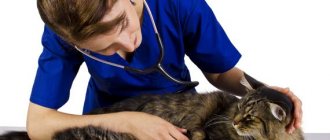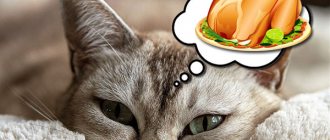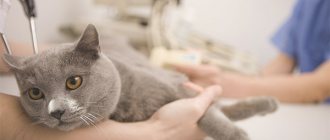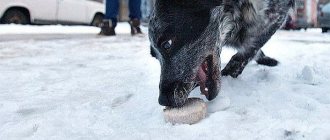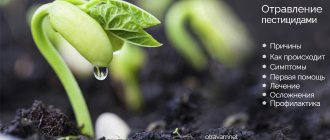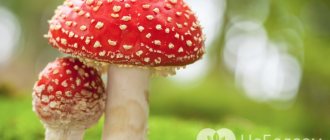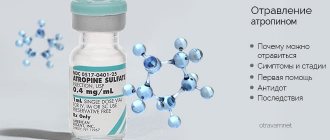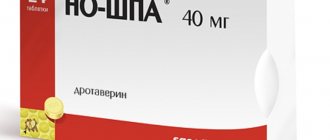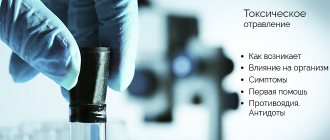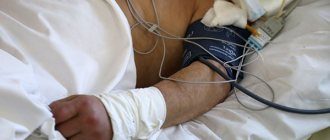The increase in the rodent population in residential, public and industrial premises has forced people to take extreme measures. One of the ways to effectively kill rats and mice is considered to be all kinds of poisons, among which Brodifacoum is not the least important. This drug is good in pest control due to the direct effect of the poison on the circulatory system.
Such toxic substances can easily be purchased at the market or at a specialty agricultural produce store. It is the free sale of Brodifacoum that makes it the cause of frequent poisoning, and only by knowing the main signs of intoxication and knowing how to properly provide first aid can you save the victim’s life.
Physicochemical characteristics
The substance belongs to coumarin derivatives (warfarin).
Brodifacoum, a derivative of hydroxycoumarin , is a white crystalline substance with a yellowish tint. Practically insoluble in water; slightly soluble in alcohols, benzene; soluble in chloroform and acetone. Stable in sunlight.
Pesticides containing
Brodifacoum
for agriculture:
for private farms:
for medical, sanitary and household use (concentrate):
for medical, sanitary and household use (bait):
physical characteristics
- Molecular weight 523.4;
Melting point 228-235 °C. [4]
Effect on harmful organisms
The intestinal rodenticide brodifacoum is a second-generation synthetic blood anticoagulant that disrupts the formation of vitamin K1, which is necessary for the production of prothrombin complex proteins. One day after consuming a lethal dose of the drug, the level of blood clotting sharply decreases. As a result, any internal or external damage to the rodent leads to internal bleeding and death. [6]
The content of the active substance in baits is usually 0.005%, but for use in open stations it is often 0.001%. It is one of the few anticoagulant rodenticides that causes 100% mortality in rodents after 24 hours of ingestion. [5]
According to other sources, symptoms of animal poisoning develop several days after eating the bait, death occurs on days 3-8. [3]
Lethal doses for rodents
- Acute LD50 for house mice 0.4 mg/kg;
- For black and gray rats 0.22 mg/kg; [5]
- Chronic 5-fold LD50 for rat from 0.05 mg/kg to 0.08 mg/kg.
When feeding rodents with grain bait in the absence of other food, the LD50 for the Gunther's vole was 2.28 mg/kg, and for the gerbil tristrami 0.8-0.9 mg/kg. This indicator for the pine vole is 0.36 mg/kg. [5]
Resistance
Toxicological properties and characteristics
The combination of such qualities as high toxicity for warm-blooded animals after a single consumption, cumulative properties and long periods of elimination from the body (up to 150-200 days) make it particularly important to comply with the regulations for the use of brodifacoum.
Despite the fact that for some of the non-target species the acute LD50 is significantly higher than for harmful rodents (for a dog - 3.5 mg/kg; for a domestic cat - 25 mg/kg; for chickens from 10 mg/kg to 20 mg/kg), nevertheless, the danger of primary poisoning exists and is realized from time to time. This mainly applies to cats, dogs and granivorous birds. [5]
First aid for poisoning
Hazard classes
The Toxicological data table is compiled in accordance with GN 1.2.3111-13. [1]
Story
Brodifacoum is one of the relatively new anticoagulants classified as second generation.
First synthesized in 1977 in the UK. Over the past time, brodifacoum has become widespread in most countries and is used against synanthropic and exanthropic rodents. [5]
Brodifacoum (Klerat, Talon) is an anticoagulant from the group of coumarins. Based on it, baits are made to fight rodents. Such drugs are widespread and freely available. In some cases, pets or even humans become victims of poisoning.
What is brodifacoum and how does it affect the body? How to recognize signs of intoxication, what treatment and measures to prevent poisoning are needed?
Measures to prevent rat poisoning
Measures to prevent intoxication by zoocoumarins involve creating conditions that prevent possible contact of a pet with poison for rats. It is important to ensure that your cat's food is always fresh and there is access to water.
A well-fed animal is unlikely to go looking for food in other places. If your pet has free access to the street and can visit places where rodents are poisoned (basements of residential buildings, landfills and trash bins), you must try to prevent him from entering these places.
If characteristic symptoms of ill health appear in a cat, it is important to immediately contact a veterinarian. Even if the cause of your pet’s apathy and lethargy is not rat poisoning, preventive diagnostics will not hurt.
Do you want to know more about the article or something? Call +79774692712, we will advise you.
Description
Brodifakum is an intestinal rodenticide. Belongs to the group of indirect anticoagulants - substances that reduce blood clotting. It is a derivative of coumarin. It was first synthesized in 1977 in the UK. The chemical formula is C31H23BrO3.
It is a white crystalline substance. Practically insoluble in water (less than 10 mg/l), slightly soluble in alcohols and benzene. Soluble in acetone and chloroform.
One of the important properties of brodifacoum is its stability in the environment. When exposed to temperatures of 50 °C and direct sunlight, it remains active for more than 30 days. Another feature of brodifacoum is its long elimination period. Once in the body, the poison can remain there for up to 150–200 days.
Brodifacoum
Home Directory Brodifacoum
Brodifacoum is the active ingredient of rodenticides from the class of blood anticoagulants, a derivative of hydroxycoumarin. It belongs to the second generation of anticoagulants - superwarfarins, which have a much stronger effect on rodents than warfarin and other first generation rodenticides of this group. Brodifacoum was developed in 1977 in the UK to control warfarin-resistant rat populations that were a threat to human health.
Brodifacoum molecules exist in the form of cis- and trans-isomers, the activity of which does not differ significantly; the technical product contains them in variable proportions from 50:50 to 70:30. The bromobiphenyl group ensures the stability of the molecule and overcomes the emergence of resistance to poison in rodents.
Brodifacoum is a white to fawn colored crystalline powder; melting point about 230°C, vapor pressure 133 MPa at 25°C. The substance is practically insoluble in water and ethers, slightly soluble in ethanol and benzene, highly soluble in acetone and chloroform; Remains stable in light for up to 30 days. High lipophilicity determines the ability to accumulate in fats.
Products based on brodifacoum are produced in the form of ready-to-use food baits: granules, capsules, grains, soft and hard wax briquettes; We also produce concentrates for professional use: powders, liquids and gels. The products remain effective for up to 2 years in closed containers under normal storage conditions.
Rodenticides based on Brodifacoum:
Kilmays
Efa grain bait
Hunter gel
Mechanism of action
Brodifacoum is a single-dose, chronic intestinal rodenticide that enters the body orally; its target is the circulatory system with blood clotting disorders. It reduces the level of active vitamin K by inhibiting the enzyme epoxide reductase, which is necessary to restore this vitamin from K-epoxide.
Vitamin K in the liver of mammals, which includes rodents, takes part in the biosynthesis of at least four blood clotting enzyme proteins. The most significant of these is prothrombin, which cleaves the peptide bonds of fibrinogen, a soluble blood protein, and converts it into insoluble fibrin.
The amount of vitamin K under the influence of anticoagulants gradually decreases, and causes a lack of prothrombin and other blood clotting enzymes in the blood. As a result, cerebral and gastrointestinal hemorrhages occur. In addition, toxic doses of brodifacoum increase the permeability of the smallest vessels - capillaries, which increases bleeding.
Bleeding with a single dose of 0.005% brodifacoum occurs within 24 hours; a decrease in blood volume and associated tissue oxygen deprivation for 3-5 days leads to loss of consciousness, shock and death of the target rodents. Often, in courtyards and undeveloped areas, baits with a 0.001% active substance content are used; in such cases, it takes several days for the lethal dose to accumulate.
The action of brodifacoum is close to the natural anticoagulant dicumarol, a substance of plant-fungal origin, and its synthetic analogue warfarin. At the molar level, its effect is 100 times greater than that of warfarin; In addition, brodifacoum has a long plasma half-life of at least 43 days, while the half-life of warfarin is 42 hours. These properties of the substance provide it with a powerful anticoagulant result.
Application
- In agriculture to regulate the number of voles, field mice, gerbils, gophers and other pests of winter grains, horticultural and perennial crops; also against gray and black rats and house mice, which eat and spoil grain and other supplies during storage.
- In sanitary, household and medical deratization - the destruction of rats, mice and other rodents in the premises of various objects and in open undeveloped areas.
Most ready-made baits are approved for use by the population at home and on private farms; concentrates are used by pest control specialists to prepare poisoned baits, taking into account the type of rodents and their food preferences.
Usually, artificial bitterness is added to baits - Bitrex to protect against being eaten by non-target animals (rodents do not feel the bitter taste). In order to increase attractiveness, attractants with the taste and smell of meat, fish, caramel and other favorite food of rodents are included.
Baits are placed in places where rodents live and move in bait boxes, boxes, and trays under cover. They should not be placed within the reach of children and pets, or near food, fodder, or water sources.
The main advantage of brodifacoum and other second-generation anticoagulants is the slow development of symptoms; rodents do not associate them with food, and there is no wariness or rejection of the bait. In addition, it does not cause resistance.
Toxicity
The classification of toxicity and danger of rodenticides makes it possible to assess both their potential danger for the active substance (class 1 or 2) and the actual danger for each drug.
Brodifacoum and other 2nd generation anticoagulants (bromadiolone, flocumafen, etc.) according to the DV are classified as 1 “A”. Products with the active ingredient brodifacoum have hazard class 2-3 or 4 depending on the concentration, type and form of the drug.
When administered into the stomach, the LD50 for rats is 0.27, cats – 0.25, proteins – 0.13 mg/kg body weight, that is, brodifacoum does not have a pronounced selectivity of action and is dangerous for all mammals, as well as for birds and fish. Animal studies have shown that the pure substance is irritating to the skin and eyes; carcinogenicity, toxic and teratogenic effects on the embryo have not been identified.
Acute human poisoning if ingested may be asymptomatic for several days; then there will be a decrease in the level of prothrombin in laboratory tests, bleeding gums, bruises, and nosebleeds. If you take a high dose of brodifacoum, life-threatening internal or brain bleeding may occur. Chronic poisoning develops slowly, and is especially dangerous with concomitant kidney or blood diseases.
The antidote is vitamin K1 (phytomenadione or phylloquinone); The duration of treatment is several months, since brodifacoum accumulates in adipose tissue and has a long half-life. Detoxification of the substance occurs in the liver by hydroxylation under the influence of oxidase enzymes, and decomposition products are excreted from the body.
Typically, brodifacoum is used by the bait method, in which the immediate danger to non-target animals is relatively low. An important problem is secondary poisoning of scavengers or predators, so it is necessary to promptly remove and destroy the corpses of poisoned rodents.
In the USA, brodifacoum, as well as bromadiolone, difenacoum and diphthialone, are approved for use only by pest control specialists. In Russia, moderate and low-hazard products of classes 3 and 4 are produced for widespread use based on brodifacoum. Class 1-2 products (extremely and highly dangerous) are recommended for professional use.
Effect on rodents
Brodifacoum affects all mammals equally, but its properties have been most studied in rodents. The poison is an antagonist of vitamin K and is an indirect anticoagulant. Unlike Warfarin, the effect of use occurs over time, which eliminates addiction in rodents. This is typical for the second generation of rodenticides.
The high effectiveness of brodifacoum in rats is due to the ability of the drug to accumulate in the body (cumulation). The half-life of the substance is more than a month.
The mechanism of action of brodifacoum is associated with the hemostatic system. The toxin prevents the restoration of the vitamin K1 molecule, which leads to disruption of the activation of coagulation factors II, VII, IX and X and reduces the level of prothrombin. 24 hours after receiving a lethal dose, the rodent’s blood clotting rates drop sharply. In addition, brodifacoum increases the permeability of the capillaries of the vascular bed. Rodents that receive a lethal dose of rodenticide die from massive bleeding. The mortality rate is 100%.
According to some data, animals die within a day after eating poisoned baits. According to others, symptoms of rodent intoxication with the anticoagulant brodifacoum develop several days after eating the bait, and death occurs on the 3rd–8th day.
Treating a cat for rat poisoning
Timely diagnosis of poisoning is the key to successful treatment. To make an accurate diagnosis, anamnesis is extremely important (what the animal ate the day before and what symptoms were present at the very beginning). As a rule, a veterinarian begins treatment immediately, based only on suspicion of poison intoxication.
This is due to the fact that confirmation of an accurate diagnosis takes several days, and any delay can cause death.
The basis of diagnosis is clinical signs of zoocoumarin poisoning and laboratory tests (general and biochemical blood tests). A blood test can determine thrombocytopenia, increased levels of alkaline phosphatase and liver enzyme substances. This is due to the onset of oxygen starvation. The time required to form a fibrin fiber clot increases.
Instrumental studies allow us to determine the severity of the pathology. Ultrasound examinations and an electrocardiogram are used. Ultrasound diagnostics allows you to determine the degree of damage to internal organs in the abdominal cavity.
When studying the work of the heart muscle against the background of zoocoumarin poisoning, disturbances in rhythm and general conduction of impulses are observed. It is important to use an electrocardiogram during the treatment of an animal during intoxication, which makes it possible to monitor the onset of possible complications in the functioning of the heart and blood vessels.
During diagnostic activities, a separate role is assigned to differentiation. The cause of intra-abdominal bleeding in a cat and the development of other similar symptoms with zoocoumarin poisoning may be:
- Thrombohemorrhagic syndrome is a pathology associated with disorders of blood clotting factors with massive release of thromboplastic substances from tissue structures. The pathological process may not manifest itself for a long time, but in cases of shock, serious injuries and bacterial contamination of the blood, it can enter the active phase.
- Willerbrand's disease is a pathological process that develops against the background of genetic abnormalities in the formation of platelets.
- Diseases of the liver structures.
Therapeutic measures for the acute stage of intoxication are based on the following points:
- active detoxification for the rapid removal of toxic substances from the body;
- antidote therapy - the use of specific drugs to neutralize the toxin;
- symptomatic treatment.
Treatment begins with washing the gastric contents with a solution of potassium permanganate. Next, enterosorbents and saline laxatives (sodium and magnesium sulfate) are introduced. Infusion therapy is of no small importance. A catheter is placed in a vein and large quantities of saline and glucose are injected.
Ringer-Lock solution has a good therapeutic effect. The total amount of liquid is calculated individually. On average, 50 ml per kg of live weight is required. To normalize the balance in the body, a solution of sodium bicarbonate 4% is administered in a stream or drip.
It is worth noting that the use of activated carbon for the treatment of zoocoumarin intoxication in cats is not advisable, and therefore is not used. In some cases, vitamin K injections are used to restore impaired blood factors.
After treatment, it is necessary to conduct preventive diagnostic examinations, which allows you to monitor the condition of the animal and the degree of recovery from a dangerous condition.
Toxicity
The substance is poisonous to all mammals and humans. When administered orally, the semi-lethal dose of brodifacoum is (mg/kg):
- rats - 0.5;
- mice - 0.4;
- rabbits - 0.2;
- dogs - 3.5;
- domestic cats - 25;
- chickens - 4.5;
- chickens - 10–20;
- mallards - 2.0;
- pigs - 1.0.
It can be seen that the toxicity of rodenticide for domestic animals is much less than for harmful rodents.
Brodifacoum is also dangerous for the inhabitants of water bodies; toxicity to fish is:
- for eared perch - 0.165;
- for rainbow trout - 0.051 mg/l.
Toxicity to daphnia and other aquatic invertebrates - Daphnia magna (water flea) - 0.98 mg/l.
Registered brodifacoum preparations belong to hazard classes 2 and 3 for humans. The permissible daily dose is zero.
Application
The use of brodifacoum as a rodenticide began in the 80s of the 20th century. The drug is effective in rodent populations resistant to Warfarin. That is why it is also called “super warfarin”.
Brodifacoum is the active ingredient in baits for the destruction of rodent pests - mice, voles, rats, gophers and others. It is also used against possums.
Brodifacoum is used wherever rodent extermination activities are carried out (deratization):
- sowing of grain and fruit crops;
- feed and food storage;
- elevators;
- livestock farms;
- food enterprises;
- personal plots;
- outlets;
- medical and children's institutions;
- basements and staircases of residential buildings.
For household and sanitary purposes, brodifacoum is used in the form of baits with a poison content of 0.005%, and in open agricultural areas - 0.001%.
Forms of release of brodifacoum concentrate:
These preparations are used by sanitary and epidemiological service workers to prepare baits.
You cannot prepare poison yourself, as this requires special premises, equipment and skills.
There are many ready-to-use preparations for killing rodents based on brodifacoum on sale - in the form of grain, granules, hard and soft briquettes. They contain 0.005% of the active substance, less often 0.25% is used. Manufacturers add auxiliary ingredients and a dye, usually green or blue, to all these drugs.
The list of drugs containing brodifacoum for the destruction of rodents for household and sanitary purposes is as follows.
- "Hunter Antirodent".
- Valbrenta Chemicals "Rat Delight".
- "Krysin."
- "Rat Death No. 1."
- "Ratifox Plus".
- "Waratah".
- "Nutcracker".
- "Brodefort."
- "Brodifakum Grand".
- "Biorat".
- "Brodifan."
- "Bromed."
- "Rattikum."
- "Hunter."
The following brodifacoum preparations are used in agriculture.
- Valbrenta Chemicals "Smart Cat" Brodirate.
- "Deadmais."
- "Isocine."
- "Kilmays."
- "Kilrath Super."
- Klerat.
- "Mortorath."
- "The final".
- "Cyclone".
Baits with brodifacoum are prepared from a concentrated solution or gel. Wheat, oats, sunflower seeds, and peas are used as fillers. In the meat processing industry, baits are mixed with meat residue.
Human poisoning
Brodifacoum intoxication in humans is possible in two cases.
- Violation of safety precautions when working with poison.
- Accidental eating of bait by children. This happens if the bait is not laid out correctly or rodents take it to accessible places.
Brodifacoum acts not only when it enters the body through food, it can be absorbed through the skin, causing local irritation. Inhaling the powder and getting it on the mucous membranes of the nose and eyes is also dangerous.
In Russia, over the past 15 years, there have been two cases of mass poisoning of children with brodifacoum - in the Vladimir region in 2007, and in 2011 in the Tyumen region. In both episodes, this was due to eating rodent baits.
Isolated cases of rodenticide poisoning have been reported throughout the country. More often this happens in the fall, when bait is scattered in houses and places where crops are stored.
The effect of brodifacoum on humans is to damage the heart and blood vessels, brain, respiratory system, liver and kidneys.
Symptoms
Acute brodifacoum poisoning in humans manifests itself 1–3 days after the poison enters the body. The main danger is massive bleeding and death as a result of hemorrhages in the internal organs and brain.
Symptoms of brodifacoum poisoning:
- nausea;
- vomit;
- diarrhea;
- lack of appetite;
- weakness;
- headache;
- sometimes body temperature rises slightly;
- pain in the abdomen and back;
- cough with sputum, with traces of blood;
- pallor;
- bleeding gums;
- nose bleed.
In severe cases of brodifacoum poisoning, symptoms intensify and there is a risk of internal hemorrhage. This is accompanied by the following symptoms:
- multiple hemorrhages in the skin and on the mucous membranes of the eyes and mouth;
- blood in urine and stool;
- stomach, intestinal, uterine bleeding.
You can die due to large blood loss, hemorrhagic stroke, hemorrhages in the kidneys and liver. In blood tests for coagulation, a decrease in the prothrombin index is noted.
First aid
In case of brodifacoum poisoning, first aid involves removing the poison from the body immediately after it enters the body.
- Induce vomiting. This must be done within 2 hours after eating the bait until brodifacoum is absorbed from the stomach into the blood.
- Take enterosorbent - activated carbon, Enterosgel, Polysorb MP.
- In case of vomiting and diarrhea, replenish fluid loss. You can drink plain water, but it is better to take oral rehydration solutions - “Hydrovit”, “Regidron”.
Brodifacoum is able to be absorbed through the skin and mucous membranes. If poisoning occurred in this way, then the following must be done.
- Remove the drug from the skin with a cloth or dry cotton swab.
- Wash the affected area with soap and water.
- Observe the condition of the victim.
- If brodifacoum rodenticide gets into your eyes, rinse thoroughly with running water or saline solution. Inspect the conjunctiva for 2–3 days. If you have the slightest concern, such as redness, itching or any discomfort, visit an ophthalmologist.
- When inhaling powder with brodifacoum, you need to rinse your mouth and nose, provide the victim with fresh air, peace, and warmth.
Symptoms of rat poison poisoning in cats
An attentive cat owner must note any changes in the health of his pet. If a cat is poisoned by zoocoumarins, it is necessary to take immediate action and contact a veterinarian. You should not self-medicate and wait for the cat’s pathological condition to go away on its own.
Intoxication of the body by zoocoumarins occurs at the biochemical level and without proper assistance, the pet dies from extensive internal hemorrhages. Without treatment, a cat has a chance to survive poisoning with warfarin or other zoocoumarins, but only if the amount of poison that enters the body is insignificant.
It is not possible to determine this on your own without diagnostic techniques and laboratory tests. Therefore, do not neglect the help of a veterinarian. The main symptoms of cat poisoning by zoocoumarins are:
- the occurrence of shortness of breath;
- pallor of visible mucous membranes;
- increased animal weakness and apathy;
- the appearance of paroxysmal cough with the release of mucus and streaks of blood;
- eruption of gastric contents with blood;
- upset stool with a large amount of blood;
- refusal of food and water;
- bloody discharge from the nasal passages;
- hemorrhages in subcutaneous fat tissue;
- pain in the abdominal area;
- lameness;
- decreased body temperature and fever.
At the same time, experts note that body temperature can remain normal, and symptoms develop gradually. Bleeding in the pleural area and abdominal cavity may go unnoticed by the human eye. The animal is wasting away, and the owner does not know the reasons.
Dog poisoning
Brodifacoum and its analogs are used by dog hunters to poison dogs. Basically, rat poison is mixed with grain or other foods unattractive to dogs. A pet can become poisoned by eating a dough cheese briquette or meat-based bait. It is also possible to receive a dose of poison by eating a rodent that has died from the effects of brodifacoum.
It is illegal to use rat poison to kill stray dogs.
For brodifacoum poisoning, the lethal dose for a dog is 3.5 mg/kg. This means that it is dangerous for a dog weighing 20 kg to eat 140 grams of bait containing 0.005% active ingredient.
Symptoms
Signs of poisoning with the anticoagulant brodifacoum in dogs usually appear between the third and fifth days. If a very large dose is received, they may occur within 12–24 hours. The clinical picture can be varied. Sometimes the animal feels good. For serious disorders, it is enough that the level of vitamin K in plasma decreases by 20%.
Symptoms of brodifacoum poisoning in dogs are as follows:
- lethargy;
- dyspnea;
- lack of appetite;
- pallor of mucous membranes;
- pink foam when coughing;
- blood from the nose;
- bleeding gums.
Vomiting and black feces indicate intestinal hemorrhage. With a large dose of brodifacoum, lameness, brown coloration of urine and feces, stroke, loss of consciousness, and convulsions develop. Hemothorax (accumulation of blood in the chest) often develops - the dog is forced to sit or stand, it has shortness of breath, pallor of the visible mucous membranes (eyes, mouth).
First aid
If a dog has eaten bait containing brodifacoum, first aid measures should be as follows:
- induce vomiting;
- give enterosorbents and saline laxative.
If signs of intoxication are already visible, then you cannot induce vomiting, as there may be bleeding.
If a dog is poisoned with brodifacoum, the animal will definitely need medical attention.
Treatment
The treatment strategy for brodifacoum poisoning depends on the timeliness of first aid and the dog owner contacting a veterinarian. If the poison was quickly removed from the body, then they limit themselves to monitoring blood counts after 24–36 hours, and then again after 96 hours. The dog is left in the hospital for at least a day, ensuring it rest.
If abnormal blood counts are detected, antidote therapy is prescribed. The antidote for brodifacoum is vitamin K1 - “Phytomenadione”. The first time it is administered intravenously at a rate of 5 mg/kg body weight. It is not advisable to do subcutaneous injections due to the risk of developing hematomas. Afterwards, vitamin K1 is given to the dog orally with food at a dose of 2.5–5 mg/kg per day, divided into 2–3 doses. The duration of the course is from 3 to 6 weeks. The drug is discontinued under the control of a hemostasiogram 36–48 and 96 hours after the last dose. It is not recommended to use Vikasol (vitamin K3) instead of Phytomenadione, as its effectiveness is questioned and it has side effects.
If the dog's anemia is mild, then a plasma infusion of 6–10 ml/kg is performed. In case of severe blood loss, they resort to transfusion of stabilized blood or direct transfusion at a dose of 12–20 ml/kg.
Brodifacoum poisoning occurs not only in dogs, but also in cats. The algorithm for providing first aid and treatment is the same.
Where can a cat find poison?
Poisoning by zoocoumarins in cats is the most common reason for visiting a veterinarian with severe symptoms of intoxication. You need to know what zoocides are and how they affect the body of a pet. This is important in order to promptly identify the onset of the pathological process and seek help from a specialist.
In addition, it is important to know where the cat can find poison and try to prevent the possibility of toxic substances entering the cat's body in the future.
Chemicals developed to poison vertebrate pests have the scientific name zoocides. This is a general group of toxins, which include rodenticides, avicides and ichthyocides. All zoocides are dangerous for cats, but most often poisoning occurs with rodenticides.
This type of poison is used to prepare food baits that help kill rodents. Rodenticides have a pronounced pathogenic effect only after contact with the mucous membrane of the digestive tract. There are acute and delayed poisons. Thus, acute rodenticides are zinc phosphide and arsenic compounds.
Chronic rodenticides are anticoagulants that do not pose a particular danger to humans. Their effect is to block vitamin K, as well as the production of a specific substance - prothrombin. Against the background of these processes, blood clotting factors are disrupted and multiple hemorrhages occur.
Rodenticides that block the work of vitamin K were created against the backdrop of studies of intoxication in sheep when eating moldy clover. Coumarin of natural origin in the body of animals was converted into the toxic compound dicumarol. During the study, warfarin (zoocoumarin) was produced.
Rodenticides based on zoocoumarin decreased their effect on rodents over time. Therefore, there were new compounds that also had a negative effect on pets. Derivatives of indanedione.
With long-term use of warfarin-based rodenticides, animals have developed resistance, and new, more powerful drugs have been proposed, which sometimes affect pets. Derivatives of zoocoumarins have a pronounced toxic effect on the body of an animal (cat, dog, rodent), with a elimination period of about 14 hours.
The main reason for cat poisoning by zoocoumarins is the owner’s oversight. An animal is poisoned only by eating bait intended for baiting rodents or by eating the corpses of rats and mice.
